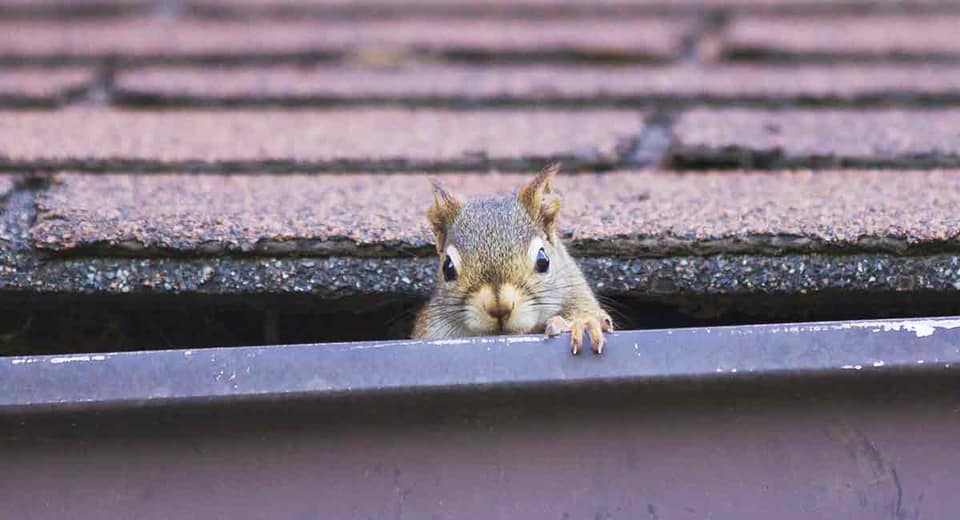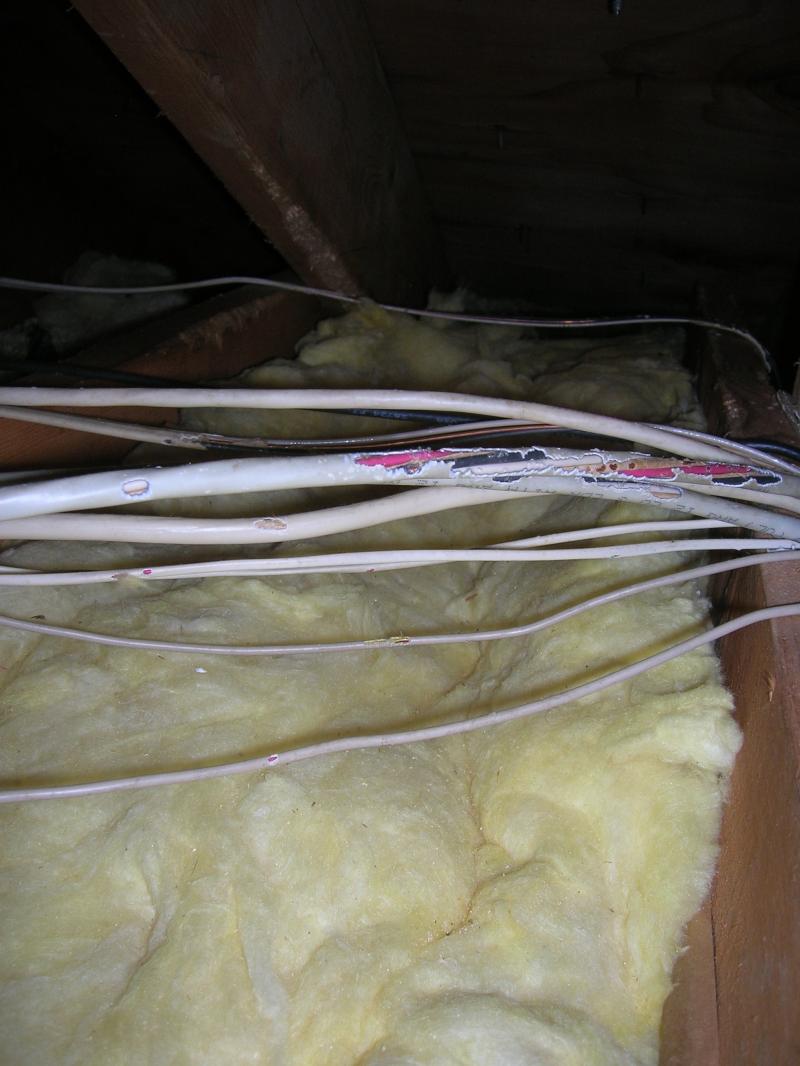
Squirrel nests are typically built high between strong tree branches, inside tree cavities, or near the base of tree trunks. Oaks, beeches, elms, and maples are common homes for both grey squirrels and red squirrels. Squirrels build nests for a safe place to give birth or to provide a dry, warm shelter during the winter. An attic provides all the necessary conditions for an excellent squirrel nest.
Squirrels are excellent climbers. Tree branches provide easy access to your roof. Squirrels typically find access points to your attic through a fascia, ridge vents, gable vents, roof returns, and soffits.
Need Help with Squirrel Removal from Attics?
Find a Critter Control near you.
What are the Signs of Squirrels in the Attic?
- Sounds. There’s a good chance you’ll hear a squirrel before you see any visual evidence, especially during winter months, where you’re less likely to notice exterior damage. The sounds squirrels make are often described as scurrying, scampering noises in attic. You might also hear chewing or gnawing sounds. Squirrels like building their nests in attics, so sounds will often emanate from there. Squirrel sounds are often mistaken for rat sounds, but there’s one key difference: squirrels are diurnal, so you’ll hear them during the day, whereas rats are nocturnal, and will make more sound at night.
- Nests in Your Attic. Squirrels are well known for nesting in attics, as they provide a safe hideaway for squirrels to raise their young. The inside of an attic is also full of things for them to nibble and sharpen their ever-growing teeth on, like wood and insulation. When a squirrel chews the insulation on electrical wiring, the possibility of a house fire arises. Squirrels enter attics through crevices, gaps, and cracks in soffits, fascia boards, and eaves, or open vents or broken shingles in the roof. Once squirrels reach the attic, they have free reign of the house.
- Squirrel Droppings Inside Your Home. Squirrel droppings are often confused for rat droppings, and vice versa. While rat and squirrel droppings do look similar—dark brown to black in color with blunted ends, around 3/8 of an inch long—they are found in different places around the home. Squirrel droppings are often found in attics or around tree trunks, while rat droppings are more common along baseboards, in cupboards, and behind large appliances like washing machines.
- Chewed Roofing Materials. Another popular nesting site for squirrels is in the roof. Typically, they build these nests with roofing insulation. Take some time to carefully analyze your home’s exterior. Squirrels commonly damage roofs by:
- Chewing holes in soffits. This can allow other small pests to invade your home.
- Biting through shingles. This can lead to water damage.
- Eating through joists and siding. This can weaken your home’s structure.
To prevent squirrels, it is critical to keep one’s roof in good shape. Regularly inspect it for any damage, and repair as needed. To cover small holes, use steel mesh, not aluminum or plastic. Squirrels can chew through plastic and soft metals like butter.
Why Do Squirrels Go in Attics?
Squirrels have different motivations to enter your attic. Squirrels can have two litters a year. It will vary depending on what part of the country they live. Generally, a squirrel will have a litter in the spring and a second in the early autumn.
Squirrels do not hibernate. They do need a warm shelter that provides protection from harsh winter weather.
They gain access to attics by chewing holes above gutters or at construction gaps where dormers meet the roofline. Squirrels will also chew corners of trim or any weak area that gives them access to a shelter.
What Damage Can Squirrels Cause in Attics?
Squirrels often cause damage to attic insulation or electrical wiring in the attic. But the most damage is done over time as multiple litters of squirrels are born in or near the home. As these squirrels grow and leave the nest, they often will set up their own nests within the same attic.
If the initial intrusion is not addressed in time, the damage to your home will increase quickly. Not only will they continue to chew through wiring and damage insulation, but in doing so, they will create more entry points for other squirrels.
How Critter Control Gets Rid of Squirrels in the Attic
The best and safest way to remove squirrels from your attic is by calling the experts at Critter Control. Never approach nuisance squirrels without professional help. Squirrel repellents do not provide a long term squirrel control solution. Mothballs are dangerous. Bright lights will initially scare the squirrels away, but eventually they will grow used to them.
One-Way Doors
This is the safest method of squirrel removal. First, you must locate all the entry points the squirrels are using. Then you must install the one-way door, making sure there are no gaps around it. After installing the one-way door properly, seal all other entry points in the attic so the squirrels will have only one way to leave—through the door. After the squirrels leave, remove the door and seal the entry.
Note: One-way doors can separate mother squirrels and their young. This can result in a rather inhumane situation: mother squirrels doing serious damage to your house while trying to get back in to retrieve their babies, and these babies starving. Therefore, if squirrel babies are part of the equation, we recommend contacting a professional wildlife removal service.
Live Traps
If a one-way door is not successful or there are babies present, using live traps with bait is another effective method to get rid of squirrels in the attic. If babies are present, you will need to retrieve the babies with proper animal handling gloves.
- Live traps should be securely placed on a roof, in an attic, or on the ground, however, choosing a location on the ground may lead to catching non-target small animals.
- When trapping squirrels, it is important to thoroughly inspect the attic before sealing entry points, because you need to ensure you caught all target squirrels.
You will need the proper PPE for the job. If squirrels are in your attic, there will likely be squirrel feces and urine in your attic, which carry bacteria that you don’t want to breathe in. Respirators and animal handling gloves should always be used.
Once the squirrels are safely removed, we identify and seal all entry points to prevent future squirrel infestations. Squirrel exclusions are the most effective, long-term solution to a squirrel problem. Critter Control uses the most advanced techniques in the industry to safely and humanely remove squirrels from your attic. Common squirrel removal techniques include a live trap or installing a one-way excluder valve.
Before performing squirrel trapping on your own, make sure you know local laws, as many states have restrictions on harming/killing squirrels. Additionally, inspect the attic thoroughly before taking any action to see if baby squirrels are present. If they are, you will need to take extra steps to remove them as well, since they cannot survive without their mother.
Attic Remediation after Squirrel Infestation
After a squirrel infestation, attic remediation is a must. This step restores your attic to a safe and clean condition, removing all traces of the squirrels’ presence.
Clean Up
Squirrel infestations leave behind contaminated materials that must be carefully removed. Our cleanup process includes:
- Safely disposing of nesting materials and squirrel droppings.
- Using specialized sanitation agents, such as industrial-grade disinfectants, to disinfect the area.
- Eliminating harmful bacteria and odors to make your attic a safe environment once more.
Remove and Replace Insulation
Your uninvited attic guests may damage insulation during their stay, nesting in it and contaminating it with urine and droppings. During our inspection, we’ll evaluate the insulation and replace it if necessary. Generally, we recommend insulation replacement when:
- Areas are heavily contaminated with rodent waste.
- Insulation has suffered significant water damage.
- Insulation is old and no longer effective.
- There are signs of mold or mildew growth.
We can help prepare insurance bids for insulation replacement to ensure a seamless transition. We work with most major insurance companies to ease the financial burden.
TAP Pest Control Insulation
As part of the remediation process, we offer Thermal Acoustical Pest (TAP) Control Insulation. This is a specialized insulation that offers multiple advantages over run-of-the-mill insulation, including:
- Pest resistance: TAP insulation is infused with boric acid, which deters insects and other pests.
- Energy efficiency: It helps with temperature regulation, adding a layer of insulating protection that reduces heating and cooling costs.
- Noise reduction: TAP insulation offers superior soundproofing compared to traditional insulation, helping keep your home quieter and more comfortable.
We install TAP insulation to provide long-term protection against future infestations while improving energy efficiency and reducing noise.
Contact Critter Control Today
If you suspect you have a squirrel infestation in the attic or need help getting rid of squirrels, our experienced team at Critter Control is here to help. We’re experts in safely and humanely eliminating pest infestations, including rodent infestations, in attics. After eliminating the problem, we won’t leave your attic in shambles—we’re experts in attic remediation, too.
Get them out.
Keep them out.®
Experiencing a wildlife or pest issue? We can help! Complete this form and your local Critter Control® office will contact you to assist.
- How to Get Rid of Squirrels
- Squirrels Entering Homes
- Squirrels in Chimneys
- Squirrels on Roofs & in Soffits
- Squirrels in Walls
- Squirrels in Ventilation
- Squirrels in Gutters
- Squirrels in Crawl Spaces
- Squirrels in Yards or Gardens
- Squirrels in Trees
- Squirrels Digging Holes in the Ground
- How to Identify Squirrel Sounds
- Squirrel Tracks
- Squirrel Droppings
- Squirrel Trapping
- Squirrel Repellents & Deterrents
- Squirrel Appearance & Identification
- Species & Types of Squirrels
- Squirrel Life Cycle
- Baby Squirrels
- Squirrel Nest
- Dead Squirrels
- Squirrel Diet
- Diseases That Squirrels Carry
- Rabid Squirrels
- Do Squirrels Hibernate?
- Gray Squirrels
- Do Squirrels Bite?
- Squirrel Damage to Your House
- Squirrels vs. Rats
- Squirrels vs. Chipmunks
